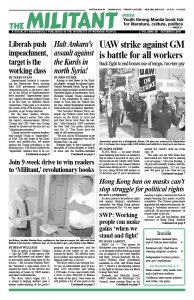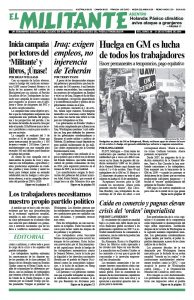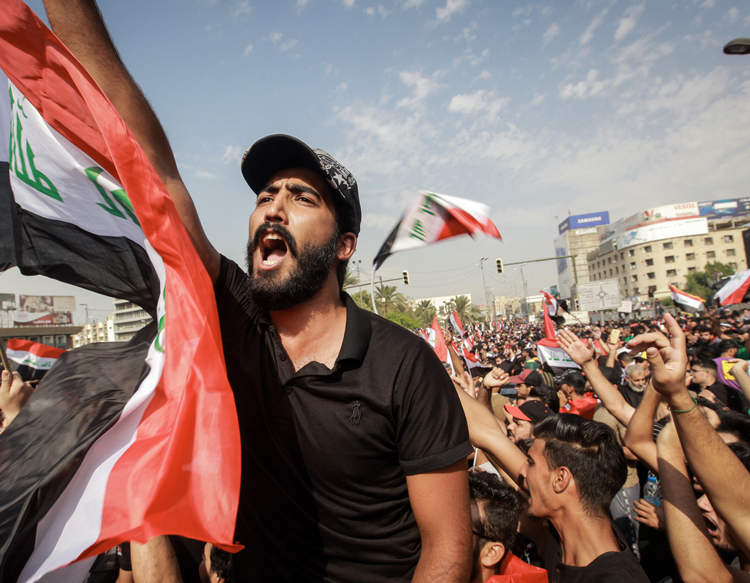Despite unbridled government and paramilitary assaults that have left over 100 dead, 6,000 wounded and hundreds jailed, working people continue to protest in Baghdad and cities across southern Iraq. They are demanding an end to years of unemployment, widespread corruption and the Iranian rulers’ military and political interference in the country.
The actions, which began Oct. 1, take place as Washington continues to intensify its sanctions against Tehran that have made life difficult for workers in Iran. The rulers in the U.S. and Iran both have forces stationed in Iraq and vie for influence against each other. Washington maintains 5,000 troops in the country to defend the interests of the U.S. rulers and push back Tehran’s military and political power there.
The Baghdad government is still largely dependent for its military defense on Shiite militias organized by the Iranian Revolutionary Guards.
Working people have used the opening of political space since the defeat of Islamic State — which had seized large parts of Iraq in 2014 — to organize widespread protests against successive Iraqi governments, first in the summer of 2018 and again today.
Protesters demand jobs, improved supplies of electricity, water and sanitation, and removal of Tehran’s grip from the country. Increasingly they demand the removal of the government of Prime Minister Adel Abdul Mahdi, which took office a year ago. While insisting he will meet many of the protesters’ demands for change, Mahdi’s government has responded with curfews, cutting off the internet, arrests and assaults.
Politicians have been “stealing, stealing from the year 2003 until now,” Yousif Emad, a 25-year-old unemployed worker with a wife and child, told the Financial Times Oct. 5. “Enough.”
“Our rights have been taken. Our dreams were taken,” Emad said, as he tried to get past government security forces to reach fellow protesters in Baghdad’s central square.
“I live in a very small house in a bad neighborhood,” he said. “No sewage, no electricity, no water. How do you expect me to live?”
Official unemployment figures have not dropped below 8% over an entire two decades, with youth unemployment remaining double that figure.
With disdain for these growing hardships working people face, Mahdi said Oct. 4 his government had “no magic solution.”
The next day, government forces opened fire on protesters in Baghdad with water cannons and tear gas grenades. Saraya al-Khorasani paramilitaries, one of the Tehran-backed forces, started using live ammunition. “They had snipers in buildings targeting the protesters,” one marcher told the media.
The leader of the largest bloc in parliament, Shiite cleric Muqtada al-Sadr, pulled his forces out of the assembly Oct. 5, calling for new elections. A few other parties have followed suit.
Actions target Tehran’s intervention
Some participants carry photos of former deputy head of Iraqi counterintelligence operations Abdul-Wahab al-Saadi, who the government replaced Sept. 27. Saadi wanted to limit the power of Tehran-backed militias known as the Popular Mobilization Forces.
Under pressure from Washington, Mahdi issued an order in July to bring the Tehran-backed militias under greater government control. But they still retain widespread sway.
“Iran and Iraq are two nations whose hearts & souls are tied together,” Ayatollah Ali Khamenei, the Supreme Leader of Iran’s bourgeois clerical government, tweeted Oct. 7. “Enemies seek to sow discord but they’ve failed & their conspiracy won’t be effective.”
The aim of Iran’s capitalist rulers is to increase their regional power and influence by force of arms, extending the nearly four-decade-long political counterrevolution that pushed back the workers, farmers, women and oppressed nationalities who carried out the historic Iranian Revolution of 1979.
That was a far-reaching, popular social revolution, not a religious jihad as the U.S. rulers and their media falsely portray it. Workers organized councils in factories, refineries and elsewhere and fought to extend their reach over politics.
The bourgeois-clerical figures who rule in Tehran today came to power in a counterrevolution that pushed back against the toilers who led the massive mobilizations in 1979. It was not until the mid-1980s, on the heels of a long, bloody war with Saddam Hussein’s Iraq, that the predecessors of today’s Iranian regime were able to consolidate power.
Since then they have made gains in extending their reach in the region, backing the Bashar al-Assad dictatorship in Syria, Hezbollah in Lebanon, Houthi rebels in Yemen, and in Iraq.
Tehran’s rulers won a victory when the Iraqi government re-opened its border crossing with Syria at Qaim, Sept. 30 for the first time in eight years, giving a boost to Tehran’s efforts to resurrect Syria’s Assad. Tehran-backed militias have control of much territory along Iraq’s Syria border.


